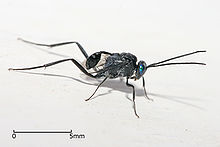Evaniidae
| Evaniidae | |
|---|---|
 |
|
| Evania appendigaster | |
| Scientific classification | |
| Kingdom: | Animalia |
| Phylum: | Arthropoda |
| Class: | Insecta |
| Order: | Hymenoptera |
| Suborder: | Apocrita |
| Superfamily: | Evanioidea |
| Family: | Evaniidae |
| Diversity | |
| Around 20 living genera | |
| Synonyms | |
|
|
The Evaniidae, also known as the ensign wasps, nightshade wasps or hatchet wasps, are a family of parasitic wasps. They number around 20 extant genera containing over 400 described species, and are found all over the world except in the polar regions. The larvae of these solitary wasps feed on cockroaches, and develop inside the egg-cases (oothecae) of their hosts.
Evaniidae have the metasoma attached very high above the hind coxae on the propodeum, and the metasoma itself is quite small, with a long, one-segmented, tube-like petiole, and compressed laterally over most of its length (segments 2-8). The ovipositor is short and thin. When active, these wasps jerk the metasoma up and down constantly, as referenced in their common names. The mesosoma is high, short, and heavily sclerotized, with a ridged and pitted surface. The head is largely immovable and attaches to the metasoma on a short neck, with usually 13-segmented antennae that do not differ between males and females.
Apomorphies of ensign wasp wings and their are:
As far as is known, ensign wasp larvae are predatory on the eggs of cockroaches. But good host data are only known for a fraction of this family, about 4% as of 2008, thus more unusual life history strategies likely exist. Host specificity and coevolution with roach lineages seem to have played a significant factor in the evolution of some ensign wasp lineages. Others are less discriminating in their host choice, and will attack almost any ootheca of a particular size.
...
Wikipedia
